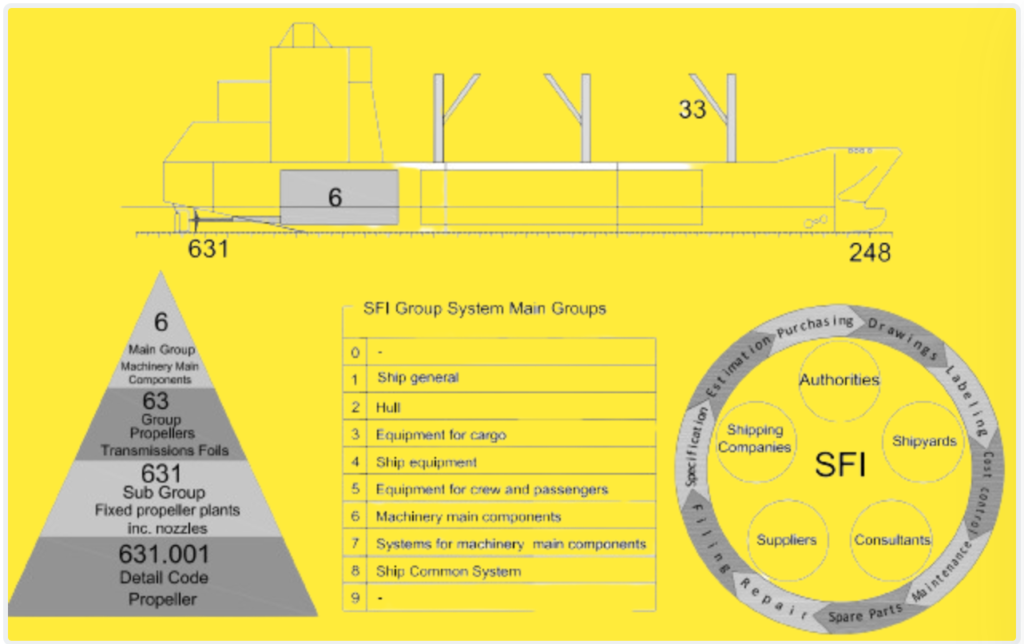Ship classification refers to the process used in the maritime industry to organize and manage technical information related to ship systems and components. These systems play a important role in weight assessment, cost estimation, and production planning during the design, construction, and operation of ships. By providing standardized frameworks for categorizing and organizing data, ship classification systems facilitate efficient communication and decision-making among shipyards, ship operators, and other stakeholders involved in the maritime sector.
Ship Classification
There are several ship classification systems available, each tailored to meet specific industry requirements and standards. Three fundamental classification systems commonly used in the maritime industry include:
- MARAD (MARitime Administration): Developed and utilized by the United States maritime administration, the MARAD classification system is designed to meet the specific needs of the U.S. government and regulatory authorities. It provides a structured framework for organizing technical information related to ship specifications, weight assessment, and cost estimation.
- SWBS (Ship Work Breakdown Structure): Employed by the United States Navy, the SWBS classification system offers a systematic breakdown of ship systems and components, allowing for detailed analysis and evaluation of shipbuilding and repair costs. It helps in organizing procurement information for materials, equipment, and services needed for naval vessels.
- SFI (Ship Forsaking’s Institute): Developed by the Norge Skips Forsaking’s Institute (NSFI) of Norway, the SFI ship classification system is now owned by XANTIC. It provides a comprehensive framework for categorizing ship-related data and supporting various aspects of ship design, construction, and operation. The SFI system is widely used in the Norwegian maritime industry and beyond.

SFI Classification System
The SFI (Ship Forsaking’s Institute) classification system stands out as the prominent ship classification framework in the maritime and offshore industries. Renowned for its comprehensive technical account structure, SFI covers all aspects of ship and rig specifications, making it a fundamental standard across the shipping and offshore sectors. This system serves as a versatile tool applicable to various systems within these industries, providing a common foundation for technical specifications and management processes.
In shipbuilding, the SFI grouping system plays a crucial role in estimating the weight of system components, thereby aiding in the assessment of a ship’s lightweight and deadweight. Moreover, it facilitates price estimation by offering a structured approach to evaluating the costs associated with different system components.
During operations, shipping companies benefit from the SFI system’s ability to streamline various functions such as purchasing, accounting, maintenance, and technical records management. By integrating these aspects, the SFI system helps in enhancing operational efficiency and ensuring effective control over different processes.
The SFI classification system employs a hierarchical structure, introducing a 3-digit decimal ship classification format. The ship is divided into ten main groups, numbered from 0 to 9. However, only main groups 1 to 8 are actively utilized, with groups 0 and 9 reserved for classifying other main components not covered by the SFI standard. Each main group is further subdivided into ten sub-groups, providing a detailed framework for categorizing and organizing ship systems and components according to their functionalities and characteristics.
SFI Groups
The main groups within the SFI classification system offer a structured breakdown of ship systems and components according to their functions and characteristics:
- Group 1: This category encompasses general costs and details that do not fall under any specific group, including aspects such as general arrangement, launching, and drydocking.
- Group 2: Includes components related to the hull, superstructure, and material protection of the vessel, covering essential structural elements and protective measures.
- Group 3: Encompasses cargo equipment and machinery, including loading and unloading equipment essential for handling cargo onboard.
- Group 4: Covers ship-specific equipment and machinery, including navigational equipment, maneuvering machinery, anchoring equipment, and communication systems vital for ship operations.
- Group 5: Focuses on equipment serving crew and passengers, such as lifesaving appliances, furniture, catering equipment, and sanitary systems, ensuring the safety and comfort of personnel onboard.
- Group 6: Comprises main machinery components, including main engines, auxiliary systems, propellers, boilers, and generators, essential for propulsion and power generation.
- Group 7: Includes equipment serving main machinery, such as fuel and oil lubrication systems, starting air systems, exhaust systems, and automation systems, supporting the operation and maintenance of main machinery components.
- Group 8: Encompasses ship common systems, including ballast and bilge systems, firefighting equipment, and electrical distribution systems, essential for overall ship functionality and safety.
Ship Weight Classification
The ship classification of weights for ships involves dividing the total displacement into two main categories: lightship weight (WLS) and total deadweight (DWT). Lightship weight encompasses several components:
WLS = Ws + WM +Wo + Wmargin
- Structural weight (Ws): This includes the weight of the ship’s structural elements.
- Propulsion machinery weight (WM): This comprises the weight of the ship’s propulsion systems.
- Outfitting weight (Wo): This accounts for the weight of outfitting and auxiliary equipment.
- Margin or reserve (Wmargin): This is a reserved weight margin for unforeseen circumstances or additional equipment.
The ship’s deadweight is defined as: DWT = DWTC + DWTFO + DWTLO+ DWTFW + DWTC&E + DWTPR
On the other hand, the ship’s deadweight consists of various components:
- Cargo deadweight (DWTC): This is the weight capacity available for cargo.
- Fuel oil weight (DWTFO): This represents the weight of fuel oil carried by the vessel.
- Lube oil weight (DWTLO): This includes the weight of lubricating oil onboard.
- Freshwater weight (DWTFW): This accounts for the weight of freshwater stored onboard.
- Crew and effects weight (DWTC&E): This encompasses the weight of the crew and their effects.
- Provisions weight (DWTPR): This includes the weight of provisions and supplies onboard.
The contract between the shipyard and the owner typically specifies the deadweight requirements, including acceptance and rejection limits. The acceptance limit is the maximum specified deadweight below which the shipyard must compensate the owner. The compensation value is usually expressed in euros per ton. Conversely, the rejection limit is the specified deadweight below which the owner has the right to reject the ship.